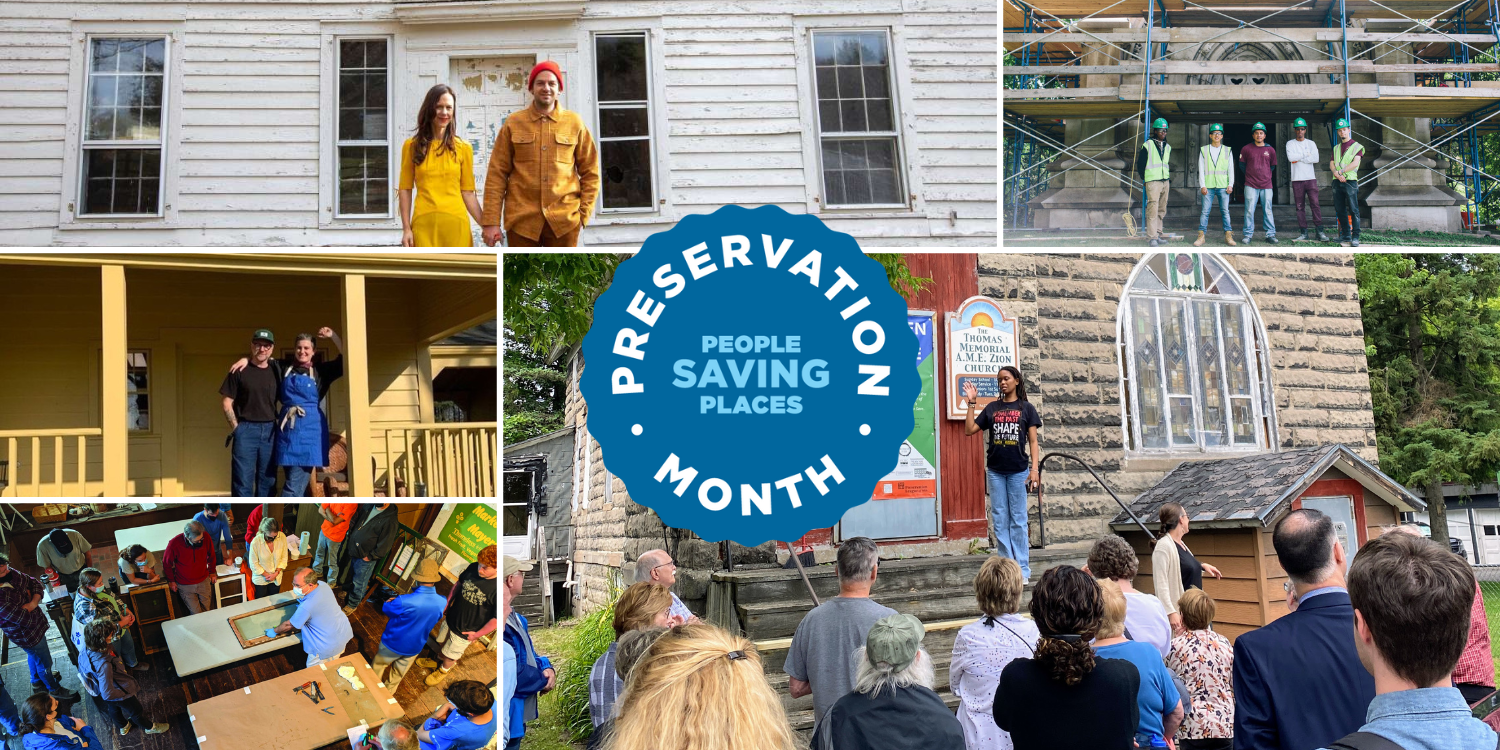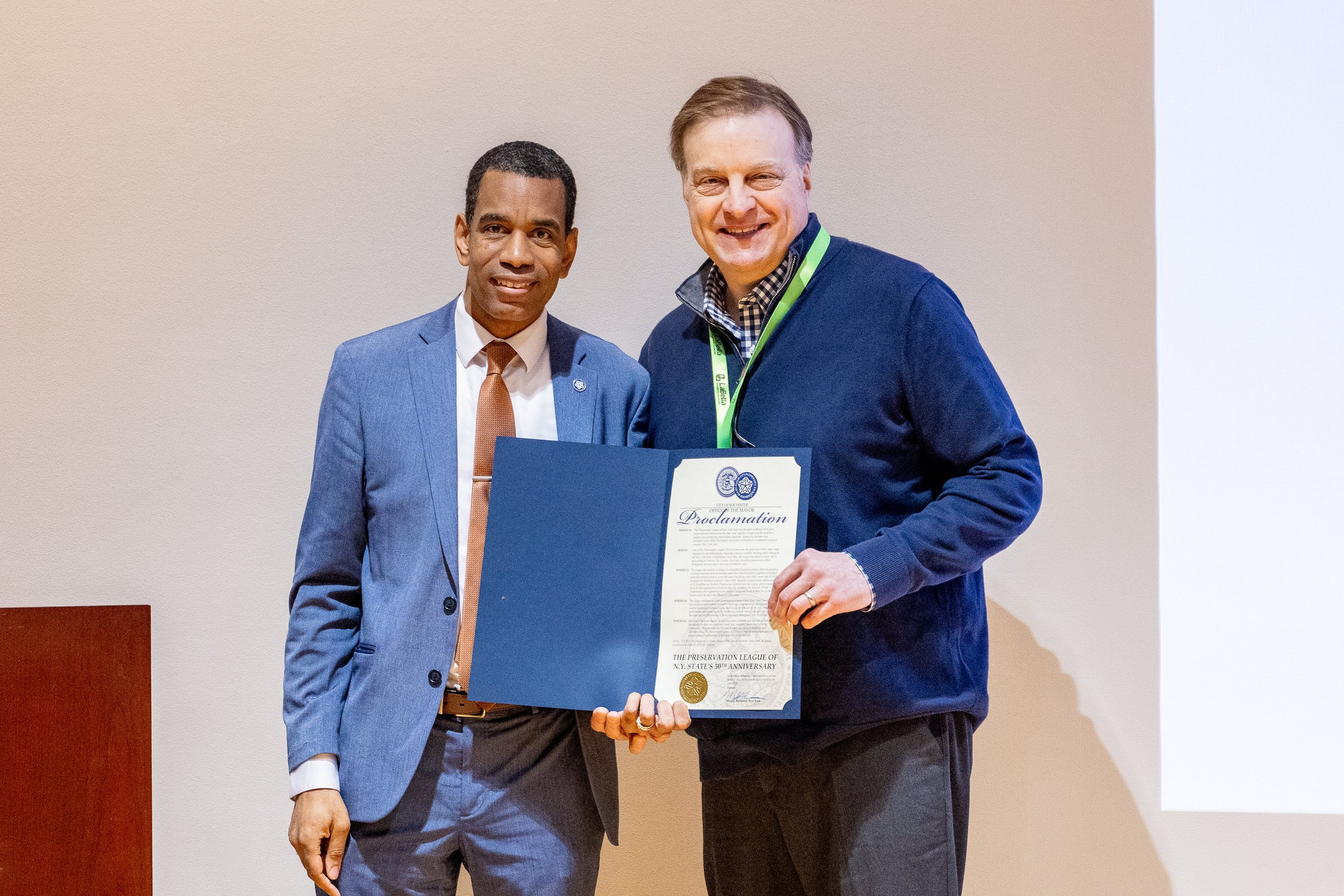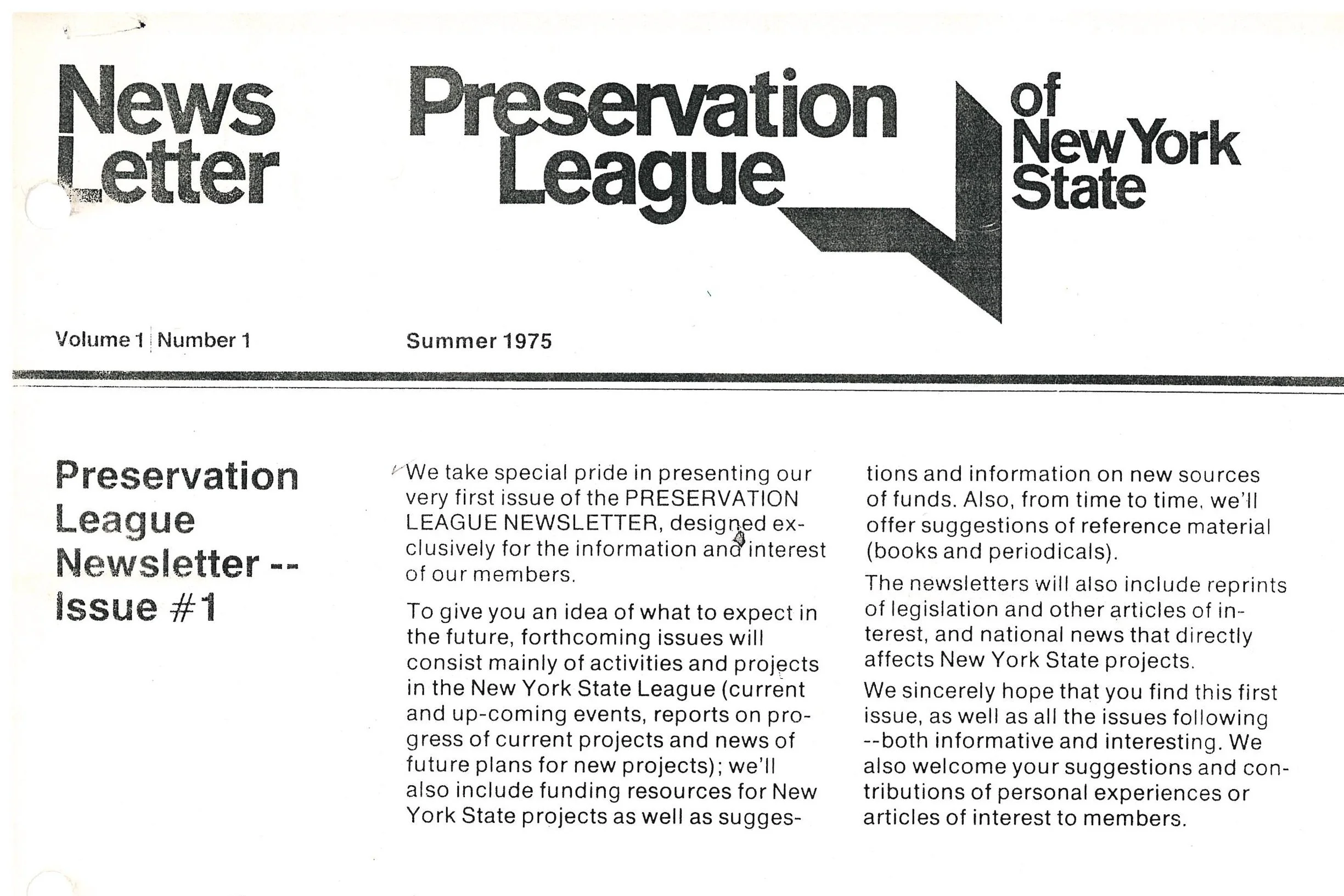Preservation League 50th Anniversary
The Preservation League was founded in 1974. Join us as we celebrate our 50th anniversary throughout 2024.
In mid-1973, preservationists from across the state gathered for a weekend in the southern Albany County hamlet of Rensselaerville at the urging of the New York State Council on the Arts. Through their discussions they came to the conclusion that New York needed a private organization to provide a clear, unified voice for preservation across the State. The Preservation League of NYS was incorporated in March 1974.
At its founding, the organization’s purpose was to communicate preservation ideals and help shape federal, state, and local policies to encourage the protection, sensitive use, and creative reuse of historic properties. All that remains true. But in the intervening 50 years, the League has taken its mandate of being a statewide leader seriously, and in that vein, has continued to push itself — and the field — forward.
Now as we mark our 50th Anniversary, we are excited to celebrate all that we have accomplished over the past 50 years — but we are even more excited to look ahead at how we continue to evolve over the next 50. We hope you will join us…
Stories From Our 50 Years
As 2024 comes to a close, three members of the League team took a look back and identified a favorite experience from our work in 2024.
By the time some historic places end up on the Seven to Save list they have suffered from years of vacancy and/or significant disrepair. Our final theme in this year's anniversary retrospective will highlight three such listings that have since gone on to have incredible transformations: the former Eastman Dental Dispensary in Rochester, the former TWA Flight Center in Queens, and Bent’s Opera House in Medina.
Main Streets serve as the physical, economic, and cultural center of a community, home to municipal offices, banks, local businesses, and community gathering spaces. They can be one block long or ten (or more!); rural, suburban, or urban; with simple single story wood frame buildings or high style multi-story masonry buildings, and everything in between. Over the past 25 years, many Main Streets across the state have landed on our Seven to Save list – from Downtown State Street in Schenectady back in 2000 to the listing of Downtown Oneonta’s Historic District just last year.
By our count, almost 20 neighborhoods have been included as Seven to Saves over the years – not counting Main Streets! Two threats tend to loom largest over Seven to Save communities: development pressure and deterioration. Gentrification, rising housing costs, and overdevelopment can push longtime residents out of their homes. Systemic disinvestment and lack of resources can make it difficult for residents to take care of their historic homes. Tools like historic district designation, Homeowner historic tax credits, and a push for affordable housing in historic neighborhoods helps to build sustainable communities. Neighborhood groups, local preservation and community-based organizations, and neighborhood residents (whether they be homeowners or renters) are the driving forces in preserving these kinds of sustainable communities.
The Preservation League was honored to be recognized by our colleagues at the Albany County Historical Association (ACHA) during their "Raise the Roof" Gala on Thursday, November 7. The League was awarded alongside the New York State Library, and the Rapp Road Historical Association, in recognition of their work to promote the rich and diverse history and culture of our region, and more broadly, all of New York State.
“Upstate and downstate, in cities and rural villages, the League is committed to a preservation movement that is truly for everyone. And your support makes that work possible – so our past has a future.”
In many ways, New York is defined by its relationship to water. New York City and Long Island are surrounded by it. The Hudson River shoots north all the way into the Adirondacks. The Finger Lakes are home to picturesque landscapes and thriving communities. Lakes Ontario and Erie form our western border. And of course, the Erie Canal is the reason New York is called the Empire State. Our coastal, river-, lake-, and canal-side communities are rich in history. But being on the water can also put historic structures at risk – from natural erosion and increased flooding caused by climate change to development pressure caused by increased real estate value.
The League’s annual grant from the Donald Stephen Gratz Preservation Services Fund was awarded to the Landmarks Society of Greater Utica. The $12,000 grant will fund restoration of the portico at the Miller-Conkling-Kernan Residence at 3 Rutger Park. This 1830 Greek Revival mansion was designed by noted Albany architect Phillip Hooker. Because of its architectural significance and its association with several prominent historical figures, the house is a designated National Historic Landmark (NHL) — one of only two NHLs in Utica.
With shifts in population, budget constraints, and older buildings no longer meeting contemporary needs, many educational buildings have been vacated and left to deteriorate without an immediate new use on the horizon. In some cases, the buildings are so large that finding a new use proves difficult. In others, districts outgrow their historic buildings and move on. Regardless of particular circumstances, educational buildings tend to be local landmarks, deeply connected to a community’s identity and sense of place. People often have a strong emotional connection to these places because they used them as a children, or members of their families did. Losing these places can be a major blow to a community.
Since 1997, the League’s Preservation Colleagues program has strengthened the work of preservationists across the state. Our Colleagues are the front-line advocates and the behind-the-scenes heroes working on behalf of endangered landmarks, historic neighborhoods, rural landscapes, and commercial centers in their respective service areas. This year, we prioritized the Colleagues program by focusing on three core areas that have made this program so valuable in the past: Networking, Training, and Advocacy.
Now in its 40th year, the League's annual Excellence Awards program allows us to shine a light on the people who are using historic preservation to make all our lives better —through exemplary restoration projects, indispensable publications, individual action, and organizational distinction. This year’s Award winners will be recognized at a public reception in NYC on Friday, November 15. Event details can be found here.
Our colleagues at Historic Albany Foundation are also marking their 50th Anniversary this year. Add to that a big move they have planned, and they have been spending time sifting through their archives and highlighting treasures from their past. We were thrilled when they came across a cache of historic photos of our Albany HQ at 44 Central Avenue. In this guest blog post, HAF President Pam Howard gives us a history lesson on the building that at one time was also home to HAF!
Waterways, roadways, railways, and airports – the architecture of how we get around can tell us a lot about the time in which it was constructed and how our communities have evolved and developed over the years. Whether purely utilitarian in its original conception or a grand statement of forward-looking aspirations, many great buildings and structures have fallen out of use and landed on our Seven to Save list. But just because something can no longer be used for its original purpose doesn’t mean it can’t still be useful.
When highlighting underrepresented histories through a Seven to Save listing, it is key for the League to bolster the work already being done by local advocates. It is not necessarily our job to come in and declare a place important — local communities are able to decide that for themselves. Rather, the League can play an important role supporting and advocating alongside the people with roots in these places.
he Preservation League of NYS is thrilled to share that three capital projects will receive funding from the newly launched Preservation Opportunity Fund. As Preservation League President Jay DiLorenzo said when the grant program was first announced in February, “We have seen a clear need from nonprofits across the state for more grant funding specifically for capital improvement projects. Through our new Preservation Opportunity Fund, we hope to meet some of that need.”
In this post we take a look at one of the League’s major early victories. The campaign to save Great Camp Sagamore began in 1975 — just a year after the League was founded — with advocacy that saved the main camp complex, and continued in the early 1980s with a complicated legislative process that further protected the 11 historic outbuildings on the Sagamore campus.
May is National Preservation Month, and following the National Trust's lead, we'll also be celebrating "People Saving Places" to mark the occasion!
Written and narrated by Brendan Gill, this short film from 1980 was produced by the Preservation League of NYS to showcase the remarkably varied architecture found throughout the Empire State. We've brought it out of the archive and digitized the original film in honor of our 50th Anniversary in 2024.
This year’s New York Statewide Preservation Conference was back in Rochester for the first time in several years. Rochester Mayor Malik Evans was on hand to welcome conference attendees — and we were honored that during his opening remarks he recognized the League’s 50th Anniversary by presenting League President Jay DiLorenzo with a City Proclamation.
On Wednesday, March 27, alongside our colleagues at Historic Albany Foundation (who are also celebrating their 50th Anniversary!) the League received a proclamation from Albany Mayor Kathy Sheehan. In addition to the Mayor, we were honored that both Congressman Paul D. Tonko and NYS Assemblymember John T. McDonald were on hand to show their support. Relationships with elected officials like Rep. Tonko and AM McDonald are essential to our statewide work and we are grateful for their continued support of historic preservation in NYS.
On Thursday, March 14, we hosted a festive evening in New York’s iconic Rainbow Room for our 50th anniversary Pillar of New York Awards. In addition to our wonderful honorees and their guests, the room was filled with League Trustees and members of the Trustees Council, historic preservation students and recent grads, and great friends and supporters of preservation.
We are revisiting some of our past accomplishments this year as we celebrate our 50th Anniversary. In that spirit, let’s take a look at one of the League’s early advocacy campaigns: Advocating for sacred sites.
Since we first began drawing attention to at-risk places with a Seven to Save designation, some places have been lost, some are still endangered, and others have gone on to be remarkable success stories. There are lessons to be learned in all three cases. For our anniversary year, we wanted to look at the program with a thematic retrospective – highlighting seven themes we’ve seen pop up in our listings over the past 25 years. Over the course of the year, we’ll be digging into our STS archive to highlight places across the state that help tell a broader story of preservation in New York. In this post we are teasing the themes we’re going to be looking at more deeply later in the year. We hope you’ll follow along!
A lot has happened over the League’s 50-year history and we wanted to share some of the highlights that have led our organization to where it is today. This timeline gives you a broad overview of the League’s first 50 years, from our founding in 1974 to today. We’ll be digging into at least of few of these stories in more detail over the coming months as we continue to mark our 50th Anniversary. In the meantime, we hope you enjoy this infographic look at the League’s half century of preservation work in NYS!
In honor of the League’s 50th Anniversary this year, we’re looking back on past highlights and digging into our archives. One of the earliest pieces we found was the League’s very first printed newsletter, published for our members in the summer of 1975. Read on to see what was going on with preservation in NYS back then…
The Preservation League of New York State is thrilled to be starting its 50th Anniversary year with a brand-new grant opportunity for New York nonprofits. Organizations with an ownership interest in, or a long-term lease of, a historic property requiring preservation, restoration, or rehabilitation, are invited to apply for the inaugural year of funding for the League’s new capital grant program.
In thinking about all the ways we might mark our 50th Anniversary this year, we knew we wanted to work with a local artist to create something for the occasion. Albany-based illustrator Cara Hanley came immediately to mind. But how can you distill 50 years of work into a single graphic, especially covering an area as large as New York State? You can’t! But we wanted to take inspiration from some of the incredible places we’ve been lucky enough to work with over the years, representing iconic building types — an Adirondack Great Camp, rowhouses, a church, a barn — to get a feel for the kind of historic places that make up the fabric of NYS. We had no shortage of ideas to pull from, but here’s a breakdown of the real places Cara was inspired by in her final illustration.
The League’s annual Pillar of New York Awards allows us to recognize those who have demonstrated remarkable commitment to preserving and celebrating New York State’s rich history. This year’s honorees are no different. We hope you will join us in the Rainbow Room on March 14 as we celebrate four remarkable preservationists – Peggy King Jorde, Richard J. Moylan, and Melissa Auf der Maur & Tony Stone.






























